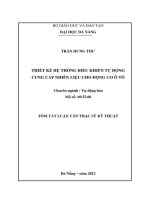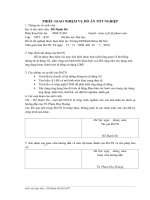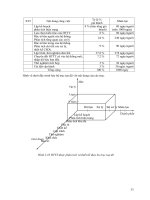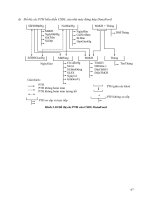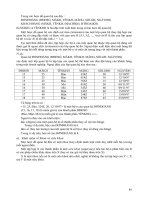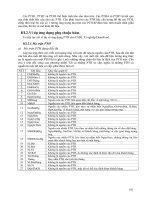Thiết kế chương trình tiếng anh chuyên ngành cho trường cao đẳng công nghiệp huế
Bạn đang xem bản rút gọn của tài liệu. Xem và tải ngay bản đầy đủ của tài liệu tại đây (5.54 MB, 266 trang )
BỘ GIÁO DỤC VÀ ĐÀO TẠO
ĐẠI HỌC HUẾ TRƯỜNG ĐẠI
HỌC NGOẠI NGỮ
HỒ THỊ QUỲNH NHƯ
THIẾT KẾ CHƯƠNG TRÌNH TIẾNG ANH
CHUYÊN NGÀNH CHO TRƯỜNG CAO
ĐẲNG CÔNG NGHIỆP HUẾ
LUẬN ÁN TIẾN SĨ
LÝ LUẬN VÀ PHƯƠNG PHÁP DẠY HỌC BỘ MÔN TIẾNG ANH
HUẾ, NĂM 2018
BỘ GIÁO DỤC VÀ ĐÀO TẠO
ĐẠI HỌC HUẾ TRƯỜNG ĐẠI
HỌC NGOẠI NGỮ
HỒ THỊ QUỲNH NHƯ
THIẾT KẾ CHƯƠNG TRÌNH TIẾNG ANH
CHUYÊN NGÀNH CHO TRƯỜNG CAO
ĐẲNG CÔNG NGHIỆP HUẾ
LUẬN ÁN TIẾN SĨ
LÝ LUẬN VÀ PHƯƠNG PHÁP DẠY HỌC BỘ MÔN TIẾNG ANH
MÃ SỐ: 62 14 01 11
NGƯỜI HƯỚNG DẪN KHOA HỌC:
TS. TÔN NỮ NHƯ HƯƠNG
TS. TRƯƠNG BẠCH LÊ
HUẾ, NĂM 2018
STATEMENT OF ORIGINAL AUTHORSHIP
The work contained in this thesis has not been previously submitted to meet
requirements for an award at this or any other higher education institution. To the
best of my knowledge and belief, the thesis contains no material previously
published or written by another person except where due reference is made.
Signature:
Date:
i
_
28 September 2018
ACKNOWLEDGEMENTS
This study would not have been completed without the help and patience of many
people to whom I would like to express my sincere gratitude.
First of all, I feel deeply grateful to both of my supervisors – Dr Ton Nu Nhu
Huong and Dr Truong Bach Le – for their continuously kind supervision and warm
encouragement.
My gratitude also goes to the lecturers of Hue University of Foreign Languages:
Assoc. Prof. Dr. Tran Van Phuoc, Dr. Bao Kham, Assoc. Prof. Dr. Pham Thi Hong
Nhung, Assoc. Prof. Dr. Truong Vien, Assoc. Prof. Le Pham Hoai Huong and Dr.
Pham Hoa Hiep who have wholeheartedly encouraged and guided me through the
fulfillment of this thesis.
I also appreciate the enthusiastic cooperation from business administration
employees from the eleven corporations in Hue City for fulfilling the questionnaires
and attending the interviews.
I would like to express my thanks to the Rector Board of my college for granting
me study leave and for their participation in this study. I am also grateful to my
colleagues at the Department of Foreign Languages – Business Administration –
Tourism for supporting me and joining this study and taking up my workload while
I was conducting the research.
I wish to express my profound thanks to my parents, parents-in-laws and my two
little daughters who always give me great strength to overcome the tough and
challenging obstacles in study and in life.
Last but not least, I feel truly indebted to my husband who is always by my side
supporting me with unconditioned love and care.
ii
ABSTRACT
The central objective of this study was to develop a vocational English curriculum
for Hue Industrial College (HUEIC) in Vietnam. The development was based on
identifying the students‟ target needs and learning needs regarding English for
business administration (BuAdmin) and on analyzing the educational environment.
A combination of quantitative and qualitative approaches was adopted with the use
of multiple instruments: document study, placement testing (with 114 BuAdmin
students), questionnaires (delivered to students and BuAdmin employees), semistructured interviews (administered to 26 students, 8 employees, 3 employers, 7
ESP teachers, 5 content teachers and 3 college administrators) and curriculum
evaluation (HUEIC panel). The research methodology was constructed based on the
statement of the problem and the theoretical discussion of situation analysis and
needs assessment for the purpose of proposing an appropriate ESP curriculum. The
triangulation of data collection instruments, sources of information and various
investigated locations helped to increase the validity and reliability of the findings.
The data obtained were analyzed through SPSS statistics, content analysis and
triangulation. The findings informed factors that were important to both the
students‟ English learning and their target careers, which are: (i) all four English
language skills were perceived important but listening and speaking were more
needed at BuAdmin workplace; (ii) language skills for job purposes namely
telephoning, speaking and listening in social situations with business partners,
writing business letters and emails, reading business texts and job interviewing
should be prioritized in the new ESP curriculum; (iii) the course contents
recommended by the participants were marketing, sales/selling, finance, human
resources and production; and (iv) content-based and skill-integrated materials
should be used with the conduction of interactive activities during the ESP program.
Accordingly, the study proposed a new ESP curriculum for BuAdmin students. It
employed an integrated model of theme-based approach, skill-based approach and
communicative approach. The primary goals of this sample ESP curriculum were to
assist the students to achieve the expected EFL learning outcomes and to promote
the students‟ English knowledge and skills for BuAdmin job contexts. Through this
English learning program, the suggestions put forth by all the participants were
catered for.
3
TABLE OF CONTENTS
STATEMENT OF ORIGINAL AUTHORSHIP
ACKNOWLEDGEMENTS
ABTRACT
LIST OF ABBREVIATIONS
LIST OF TABLES
LIST OF FIGURES
CHAPTER 1: INTRODUCTION ............................................................................... 1
1.1. Background .......................................................................................................... 1
1.2. Rationale .............................................................................................................. 3
1.3. Research objectives.............................................................................................. 5
1.4. Research questions............................................................................................... 6
1.5. Scope of the study................................................................................................ 7
1.6. Significance of the research ................................................................................. 7
1.7. Structure of the study ........................................................................................... 9
Chapter 2: LITERATURE REVIEW ....................................................................... 10
2.1. Introduction........................................................................................................ 10
2.2. Language curriculum design.............................................................................. 10
2.2.1. Definition of the term curriculum................................................................... 10
2.2.2. Difference between syllabus and curriculum ................................................. 11
2.2.3. Model of language curriculum design ............................................................ 12
2.2.3.1. Environment analysis ............................................................................... 14
2.2.3.2. Needs analysis .......................................................................................... 14
2.2.3.3. Following principles ................................................................................. 15
2.2.3.4. Setting goals ............................................................................................. 16
2.2.3.5. Content and sequencing............................................................................ 17
2.2.3.6. Format and presentation ........................................................................... 17
2.2.3.7. Monitoring and assessing ......................................................................... 17
2.2.3.8. Evaluation................................................................................................. 18
2.2.4. Curriculum approaches in language teaching ................................................. 19
2.2.4.1. Forward design ......................................................................................... 20
2.2.4.2. Central design ........................................................................................... 20
4
2.2.4.3. Backward design ...................................................................................... 21
2.3. English for Specific Purposes (ESP) ................................................................. 22
2.3.1. ESP.................................................................................................................. 22
2.3.1.1. Development and definition of ESP ......................................................... 22
2.3.1.2. Characteristics of ESP .............................................................................. 24
2.3.1.3. ESP types.................................................................................................. 25
2.3.2. English for Business Purposes (EBP) ............................................................. 26
2.3.3. ESP and needs analysis................................................................................... 29
2.3.4. ESP needs ....................................................................................................... 31
2.3.5. Approaches to ESP curriculum design ........................................................... 35
2.3.5.1. Language-centred approach ..................................................................... 35
2.3.5.2. Skills-centred aproach .............................................................................. 36
2.3.5.3. A learning-centred approach .................................................................... 37
2.3.6. Theory to language instruction ....................................................................... 37
2.3.6.1. Communicative approach ......................................................................... 37
2.3.6.2. Task-based approach ................................................................................ 39
2.3.6.3. Theme-based instruction .......................................................................... 40
2.4.The current English curriculum at HUEIC ......................................................... 47
2.5. Previous studies related to the current research................................................. 49
2.6. Chapter summary ............................................................................................... 52
Chapter 3: METHODOLOGY ................................................................................. 53
3.1. Introduction........................................................................................................ 53
3.2. Research design ................................................................................................. 53
3.3. Data collection ................................................................................................... 55
3.3.1. Participants...................................................................................................... 60
3.3.1.1. Business administration students ............................................................. 61
3.3.1.2. Business administration employees ......................................................... 62
3.3.1.3. ESP teachers and content teachers ........................................................... 63
3.3.1.4. HUEIC administrators .............................................................................. 64
3.3.2. Instruments...................................................................................................... 65
3.3.2.1. Document study........................................................................................ 65
3.3.2.2. Placement testing...................................................................................... 66
3.3.2.3. Questionnaires .......................................................................................... 70
5
3.3.2.4. Interviews ................................................................................................. 74
3.3.2.5. Curriculum evaluation .............................................................................. 78
3.4. Data analysis ...................................................................................................... 79
3.5. Reliability and validity ...................................................................................... 81
3.6. The role of the researcher .................................................................................. 84
3.7. Ethical issues...................................................................................................... 85
3.8. Chapter summary ............................................................................................... 85
Chapter 4: FINDINGS AND DISCUSSION............................................................ 86
4.1. Target needs analysis ......................................................................................... 86
4.1.1. Employers‟ expectations of their employees‟ English competence ............... 86
4.1.2. Language requirements at work...................................................................... 88
4.1.3. Language skills for job contexts ..................................................................... 91
4.1.4. Frequency of English communicative activities ............................................. 94
4.1.5. Communicative topics at work ....................................................................... 96
4.1.6. Types of problems in English use encountered by BuAdmin employees ...... 98
4.1.7. BuAdmin employees‟ suggestions to students‟ English preparation ........... 100
4.2. The students‟ English learning needs analysis ................................................ 102
4.2.1. Students‟ purposes of learning English ........................................................ 102
4.2.2. Students‟ English proficiency....................................................................... 104
4.2.3. Students‟ assessment of their English language competence ....................... 108
4.2.4. Students‟ accessibility to learning facilities ................................................. 111
4.2.5. Perceptions about English teaching and learning ......................................... 112
4.2.5.1. Students‟ perceptions of English courses at HUEIC.............................. 112
4.2.5.2. Students‟ perceptions of language skills needed for communication .... 114
4.2.5.3. The frequency of communicative activities conducted in English ........ 117
4.2.5.4. Preference for ESP materials.................................................................. 119
4.2.5.5. Preference for learning approach ........................................................... 121
4.3. The development of a new vocational English curriculum for HUEIC .......... 125
4.3.1. The sample vocational English curriculum design ....................................... 125
4.3.1.1. Overview of the program ....................................................................... 126
4.3.1.2. Target students ....................................................................................... 129
4.3.1.3. ESP teachers ........................................................................................... 129
4.3.1.4. Physical environment and resources ...................................................... 129
6
4.3.1.5. Approaches ............................................................................................. 129
4.3.1.6. Goals and objectives............................................................................... 130
4.3.1.7. Knowledge and skills ............................................................................. 130
4.3.1.8. Course framework .................................................................................. 135
4.3.1.9. Teaching methodology ........................................................................... 141
4.3.1.10. Teaching materials ............................................................................... 142
4.3.1.11. Testing and assessment ........................................................................ 143
4.3.2. The evaluation of the sample ESP curriculum ............................................. 143
4.3.2.1. The alignment of the new curriculum to the identified needs................ 143
4.3.2.2. The college‟s evaluation of the new curriculum .................................... 149
4.4. Chapter summary ............................................................................................. 150
CHAPTER 5: CONCLUSION AND IMPLICATIONS ........................................ 151
5.1. Introduction...................................................................................................... 151
5.2. Summary of key findings................................................................................. 151
5.3. Implications ..................................................................................................... 154
5.4. Contributions of the research ........................................................................... 156
5.4.1. Theoretical contributions .............................................................................. 156
5.4.2. Pedagogical contributions............................................................................. 158
5.5. Limitations of the present study and directions for future studies ..................
160
THE AUTHOR‟S PUBLICATIONS ..................................................................... 161
REFERENCES ....................................................................................................... 162
APPENDICES ........................................................................................................................ i
Appendix A: QUICK PLACEMENT TEST .......................................................................... i
ANSWER KEYS TO THE QPT .......................................................................................... xi
MARKING KIT.................................................................................................................... xi
Appendix B: QUESTIONNAIRES ..................................................................................... xii
B1: QUESTIONNAIRE FOR BUSINESS ADMINISTRATION EMPLOYEES .............
xii Appendix B2: QUESTIONNAIRE FOR STUDENTS ....................................................
xviii Appendix C: INTERVIEW SCHEDULES ......................................................................
xxvi Appendix C1: INTERVIEW SCHEDULE WITH ESP TEACHERS..............................
xxvi Appendix C2: INTERVIEW SCHEDULE WITH CONTENT TEACHERS .................
xxvii Appendix C3: INTERVIEW SCHEDULE WITH ADMINISTRATORS .....................
xxviii
Appendix
C4:
INTERVIEW
...................................... xxix
vii
SCHEDULE
WITH
STUDENTS
Appendix C5: INTERVIEW SCHEDULE WITH BUADMIN EMPLOYEES ............... xxx
Appendix C6: INTERVIEW SCHEDULE WITH EMPLOYERS .................................. xxxi
Appendix D: TRANSCRIPTS OF INTERVIEWS ......................................................... xxxii
Appendix D2: SAMPLE INTERVIEW WITH CONTENT TEACHERS .....................
xxxiv Appendix D3: SAMPLE INTERVIEW WITH HUEIC ADMINISTRATORS ............
xxxvi Appendix D4: SAMPLE INTERVIEW WITH STUDENTS........................................
xxxvii Appendix D5: SAMPLE INTERVIEW WITH COMPANY MANAGERS................
xxxviii Appendix D6: SAMPLE INTERVIEW WITH
EMPLOYEES............................................ xl Appendix E:
STATISTICS................................................................................................ xlii Appendix
E1: BuAdmin employee questionnaires............................................................. xlii E1a:
BuAdmin employees‟ demographic data ................................................................... xlii
E1b: Reliability Statistics of the BuAdmin employee questionnaires ................................
xlv Appendix E2: BuAdmin student questionnaires ...............................................................
xlix E2a: Demographic data about the students........................................................................
xlix E2b: Reliability Statistics of the BuAdmin student questionnaires
........................................ l Appendix E3: Factor analysis results
.................................................................................. liii E3a. Questionnaires for BuAdmin
employees..................................................................... liii E3b. Questionnaires for
BuAdmin students ......................................................................... lv Appendix F:
CURRICULUM EVALUATION FORM ...................................................... lxi Appendix
G: DECISION ON ASSESSING THE NEW CURRICULUM AND THE PANEL‟S
EVALUATION ................................................................................................ lxiii
8
LIST OF ABREVIATIONS
Ad
BuAdmin
Administrator
Business Administration
CBI
Content-based Instruction
CEF/CEFR Common European Framework of Reference for Languages
CLT
Communicative Language Teaching
CNP
Communication Needs Processor
CO
Company
CT
Content teacher
EAP
English for Academic Purposes
EBP
English for Business Purposes
EE
Employee
EFL
English as a Foreign Language
ELT
English Language Teaching
EOP
English for Occupational Purposes
EPP
English for Professional Purposes
ESP
English for Specific Purposes
ET
ESP Teacher
EVP
English for Vocational Purposes
FL
Foreign Language
GE
General English
GIL/GIS
Guided independent learning/study
HUEIC
Hue Industrial College
L1
First Language
LCPP
Purposes
Language and Communication Courses for Professional
LSA
Learning Situation Analysis
M
Manager
MOET
Ministry of Education and Training
MOTI
Ministry of Trade and Industry
NA
Needs Analysis
NNS
Non-native Speaker
9
NS
Native Speaker
PSA
Present Situation Analysis
QPT
Quick Placement Test
SD
Standard Deviation
SL
Second Language
SPSS
Statistical Package for the Social Sciences
St
Student
TEFL
Teaching English as a Foreign Language
TESL
Teaching English as a Second Language
TSA
Target Situation Analysis
1
0
LIST OF TABLES
Table 2.2. Stevens‟s list of ESP characteristics ........................................................ 24
Table 2.3. Dudley-Evans and St John‟s list of ESP characteristics.......................... 25
Table 2.4. The framework proposed by Hutchinson and Waters for needs analysis 34
Table 2.6. Time distribution in English Courses at HUEIC ..................................... 46
Table 3.1. Data collection for needs analysis ........................................................... 57
Table 3.2. The data collection methods .................................................................... 57
Table 3.3. Information of workplace sites ................................................................ 62
Table 3.4. Teacher participants‟ information ........................................................... 64
Table 3.5. QPT conversion table .............................................................................. 68
Table 3.6. Placement testing results ......................................................................... 70
Table 3.7. Pilot study ................................................................................................ 74
Table 3.8. The codes of the interviews ..................................................................... 78
Table 3.9. The framework for data analysis ............................................................. 80
Table 3.10. Factor analysis results of the questionnaires for BuAdmin employees. 82
Table 3.11. Factor analysis results of the questionnaires for BuAdmin students..... 83
Table 3.12. Cronbach‟s Alpha reliability statistics of the questionnaires ................ 83
Table 3.13. Cronbach's Alpha reliability statistics of the clusters ............................ 84
Table 4.1. English standards required in the employers‟ recruitment policies ........ 86
Table 4.2. Language requirements at work .............................................................. 88
Table 4.3. Frequently used language skills for job contexts .................................... 91
Table 4.4. English texts and discourse for BuAdmin employees ............................. 93
Table 4.5. Frequency of communicative activities conducted in English ................ 94
Table 4.6. English communicative topics that BuAdmin employees were
involved in ................................................................................................................ 96
Table 4.7. BuAdmin employees‟ English language difficulties ............................... 98
Table 4.8. Students‟ purposes of learning English ................................................. 103
Table 4.9. Students‟ assessment of their English language competence ................ 109
Table 4.10. Students‟ accessibility to learning facilities ........................................ 111
Table 4.11. Students‟ perceptions of English courses ............................................ 113
Table 4.12. Students‟ perceptions of language skills needed for communication . 114
Table 4.13. The frequency of communicative activities conducted in English...... 117
1
1
Table 4.14. Students‟ preference for ESP materials ............................................... 119
Table 4.15. Students‟ preference for English learning approach ........................... 121
Table 4.16. A summary of the needs analysis findings .......................................... 123
Table 4.17. Time allotment for the English program ............................................. 128
Table 4.18. Mapping the language content of the curriculum ................................132
Table 4.19. Course framework of English for Business administration 1.............. 135
Table 4.20. Course framework of English for Business administration 2.............. 139
Table 4.21. The alignment of the new curriculum to the students‟ identified needs of
English for vocational purposes.............................................................................. 145
Table 4.22. The panel of curriculum evaluation ..................................................... 148
xii
LIST OF FIGURES
Figure 2.1. Model of the parts of the curriculum design process ............................ 13
Figure 2.2. Model of forward design ....................................................................... 20
Figure 2.3. Model of central design .......................................................................... 21
Figure 2.4. Model of backward design .................................................................... 21
Figure 2.5. Language-centered approach.................................................................. 35
Figure 2.6. Skill-centred approach ........................................................................... 36
Figure 2.7. Learning-centred approach .................................................................... 37
Figure 3.1. Research framework............................................................................... 54
Figure 4.1. BuAmin employees satisfaction with their English competence for
workplace use ........................................................................................................... 90
Figure 4.2. Students' self-evaluation of English proficiency.................................. 105
Figure 4.3. Oxford Placement Test Results ............................................................ 105
Figure 4.4. Final test result of English 1 and 2 ...................................................... 106
Figure 4.5. The English Proficiency Test results of HUEIC graduates.................. 108
xiii
CHAPTER 1: INTRODUCTION
This introductory chapter provides an overview of the thesis. It is arranged in
five main sections. First, the background to the study is briefly introduced, followed
by the rationale explaining the reason why the study was conducted. The third
section illustrates the objectives of the study while the fourth presents the research
questions. The chapter continues with the scope of the study followed by the
significance of doing this research. It ends by presenting the thesis structure.
1.1. Background
Integration and globalization have brought people closer than ever regardless
of geographical barriers. Almost everyone at any corners of the world can get
acquainted culturally, politically and socially thanks to the medium of English.
English gains its dominance among various languages by heading the expansion of
science, technology and economy. It is accepted as the international communication
language in the role of a first, second or foreign language (Cahill, 2005; Cameron,
2002).
In successful pursuit of this competitive commercial world, most nations,
especially developing countries where English is not spoken as the first language
such as China or Thailand, innovate their educational programs including English
language education as part of equipping their human resources with professional
skills (Biggs, 2006; Graddol, 2006; Kasiphar, 2003; Longworth, 2003; Naknonhan,
2004, as cited in Hart-Rawung, 2008). As a part of the Asian region, Vietnam is not
an exception when the government has realized the challenges in this ever changing
and competitive world. Economic and educational reforms have been made to
accommodate rapid changes in globalized commercial context. The implementation
of the Đổi Mới (renovation) reforms started in 1986 has brought about a longstanding consensus across Vietnamese society on the importance of education.
Along with this, Vietnam has recently integrated deeply into the world economy
and increasing globalization of world trade such as joining in the ASEAN
Economic Community in 2015 and Trans-Pacific Partnership (TPP) agreement
1
(which has been currently known as CPTPP - the Comprehensive and Progressive
Agreement for Trans Pacific Partnership signed on 8 March 2018). The wideranging integration is expected to boost Vietnamese economic growth in terms of
creating jobs; enhancing innovation, productivity and competitiveness; raising
living standards; reducing poverty; and promoting transparency, good governance,
and strong labor and environmental protections (Nhân Dân Online, 2015). In
addition to these benefits, Vietnam also faces considerable challenges in preparing
workforce for a global market economy. Vietnam needs to do more to develop the
„skills‟ or „quality‟ of the workforce - one of the three breakthrough goals of the
country‟s ten-year socio-economic development strategy for 2011 to 2020 (Vietnam
Development 2014-Main report). Under the impact of globalization in terms of
economy, culture and society, English has been prioritized as the number one
foreign language taught at all education levels in Vietnam (Le, 2007; Nguyen, 2011;
Pham, 2013; Wright, 2002, as cited in Pham, 2015, p.53).
With the purpose of enhancing the quality of the foreign language teaching
and learning (primarily English) in the national education system, the MOET has
launched a language project namely Teaching and learning foreign languages in the
state-run educational system for the 2008-2020 period (which is often called the
2020 Project) according to Decision 1400 dated 30 September 2008 by the Prime
Minister. This is considered the largest project with the biggest budget so far of
nearly 9.4 trillion VND in order to improve the nation‟s English teaching and
learning (Hoang, 2010). The goal of National Foreign Language 2020 Project is:
by the year 2015 a vivid progress on professional skills, language competency for
human resources, especially at some prioritized sectors; by 2020 most Vietnamese
students graduating from secondary, vocational schools, colleges and universities will
be able to use a foreign language confidently in their daily communication, their
study and work in an integrated, multicultural and multi-lingual environment,
making foreign languages a comparative advantage of development for Vietnamese
people in the cause of industrialization and modernization for the country.
(Vietnamese Prime Minister‟s Office, 2008)
According to the goal of the project 2020, more than 80,000 English language
teachers would be retrained to advance their qualifications. In addition, the
objective of the project is to enhance English learning for students in orientation of
meeting social demands. Among many objectives regarding foreign language
2
education set in the Project 2020, English is planned to be a compulsory subject in a
new 10-year foreign language learning program, beginning with primary language
education (starting from grade 3, then 4, 5 onward to grade 12 of high school
education) throughout the country. Within the context of this Decision, The MOET
has delivered the circular No.01/2014/TT- BGDĐT on a national framework of
reference called Khung năng lực ngoại ngữ sáu bậc dành cho Việt Nam – Six-level
framework for foreign language proficiency in Vietnam (hereafter six-level
framework) (MOET, 2014). This framework involves six language proficiency
levels equivalent to those of CEFR (Council of Europe, 2001) and defines standard
foreign language outcomes required of all graduates equivalently.
As part of Vietnam‟s National Foreign Languages 2020 Project, all school
leavers are expected to reach a language competence level (illustrated in the sixlevel framework, MOET, 2014) by the year 2020. Especially, college and university
non-English major graduates are asked to achieve level 3 (equivalent to B1-CEFR).
Even though the Project 2020 has been transited into the next phase called
Teaching and learning foreign languages in the state-run educational system for the
2017-2025 period which has been submitted to the Prime Minister, the core contents
still aims to promote the foreign language teaching and learning quality in order to
meet the demands of global integration (MOET, 2017). In orientation to the global
labor market, the Project 2020 emphasizes enhancing training programs for English
for Specific Purposes (ESP) in higher education, for instance English for
Information Technology, English for Business, English for Banking, English for
Finance, English for Tourism and English for other industries at tertiary levels
(Nguyen, 2011). This aims to prepare a workforce with an appropriate English
proficiency to meet the fast-globalized working environment.
1.2. Rationale
Tertiary education in Vietnam, as the afore-mentioned, is directed to train
students for the globalization and integration but at present there is little sign of
success. It is annually reported that despite the introduction and emphasis of English
in the educational curriculum for decades, a majority of Vietnamese students cannot
communicate well in English (MOET annual report, 2013, as cited in Pham, 2015,
p.53). This is a common problem for most Vietnamese graduates who cannot use
English effectively for job interviews or for communication in the workplace (Mai
& Iwashita, 2012; Tran, 2013; Dan Anh, 2016, cited in Le, 2016). Consequently, a
3
large number of graduates face employment difficulties. As reported by Vietnamese
researchers (Nguyen, 2010; Pham, 2010; Ngo, 2015; Tran, 2015), their low English
language proficiency, especially in workplace communication, is one of the
obstacles to job fulfilment in English-using companies. As indicated by Pham
(2010) and Tran (2012), most Vietnamese students cannot communicate in English
unless they have extra English courses. This poor English competence, as pointed
out in these studies, possibly denotes ineffective ESP curricula which are caused by
several factors (e.g. learners, teachers, methodologies, testing and assessment,
materials and syllabus).
Most ESP curricula in Vietnamese universities often concentrate on
vocabulary, grammar and macro language skills (Duong, Bui & Bui, 2005; Nguyen,
2015; Vu, 2015) while neglecting training students on professional skills. Moreover,
the majority of ESP teachers lack English knowledge for vocational purposes and
have low English proficiency (Le, 2016). This hinders their use of English as a
means of instruction in ESP classes. They mainly rely on traditional methodology
(i.e. grammar-translation and teacher-based instruction) that do not promote the
students‟ autonomy in learning English. Consequently, Vietnamese students have
few opportunities to enhance their communicative competence, especially
professional language competence (Duong et al., 2005; T. S. Le, 2011).
Due to the increasing demand for English proficiency in the time of
globalization and the imperative of the Project 2020, state-run colleges and
universities have been urged to reform their English curricula, teaching materials,
methodologies and assessment practice in order to enable their students to meet the
changing workplace demands. In pursuit of the national Project 2020, Hue
Industrial College, a vocational institution in the central of Vietnam, devised „The
Project of Foreign Language Education at Hue Industrial College for 2012-2020
period‟ (hereafter the HUEIC Project) (HUEIC, 2012a) aiming to enhance the
quality of English teaching and learning in accordance with the Recommendations
R(115), R(233), R(318), and R(472) by the Rector (HUEIC, 2012b; HUEIC, 2012c;
HUEIC, 2012d; HUEIC, 2012e).
As a teacher of English at HUEIC for more than twelve years, I am able to
observe that the students of this college face difficulties learning English though
several efforts have been made to implement the HUEIC Project. The language
proficiency of most HUEIC students is evaluated at the low level (the 20132016
4
achievement testing statistics, HUEIC, 2016a). According to the statistical data from
the Department of Training in the academic year of 2013-2014, the ratio of below 4
in the ten-point scale marking is over 50 % in the final tests. In addition, the level of
fluency and accuracy of most HUEIC graduates remains below the expected
standard. Nearly all graduates at HUEIC are unable to communicate in English at
work. This indicates that there may exist limitations in the English program and
ESP courses as well. In the position of an English teacher at this college for such a
long time, I have found that three essential steps in their development, namely
environment analysis, needs assessment and course evaluation (Nation &
Macalister, 2010) has never been conducted to check if the ESP courses address the
social demands, students‟ professional needs and learning needs of English for
vocational purposes. It is anticipated that the students‟ low English proficiency and
limited communication skills result from a possible mismatch between the current
ESP curriculum and their target needs and learning needs. Therefore, there is a dire
necessity to conduct a study to investigate the educational environment and explore
the students‟ needs of using and learning English for vocational purposes.
While it is really essential to enhance the students‟ proficiency in general
English, their professional communication needs should be satisfied in the ESP
program so that they can keep up with the trends of globalization and the mark et.
Moreover, in recognition of an increasing demand for developing the English
teaching and learning situation to prepare students for global integration and in an
effort to reform the present English curriculum to suit HUEIC project
(Recommendations R(115), R(233), R(318), R(472) and R(483) by the Rector on
the HUEIC Project) (HUEIC, 2012b; HUEIC, 2012c; HUEIC, 2012d; HUEIC,
2012e), the current research was conducted to explore the students‟ target career
and learning needs concerning the actual use of English for vocational purposes.
Then, the study comes to design a vocational English curriculum basing on the
identified needs. Due to the current need at HUEIC, the program was devised for
students majoring in Business Administration (BuAdmin). The next section
clarifies the objectives of doing this research.
1.3. Research objectives
While English language courses play a compulsory part in the curricula of
HUEIC, all of them are top-down predetermined programs with institutional needs
analysis, in which ESP curricula are not an exception. Though these courses
5
primarily aim to equip students with language knowledge and skills necessary for
their study and target jobs, it is questionable if their needs were really addressed and
met. Needs analysis, no doubt, plays a prerequisite role in any language course.
Nichols, Shidaker, Johnson and Singer (2006) confirm that a needs assessment is the
critical first step to maximize the benefits of curriculum development while Orr
(2002, p. 208) maintains that „the first step in ESP is to identify the specific needs
of the learner‟ when designing a university program or creating a workplace
training course.
For the purpose of designing a vocational English curriculum, this study
focuses on needs analysis as the first step that should be taken to shape the
curriculum development for effective ESP teaching and learning at HUEIC.
Accordingly, the research is to investigate the English language needs of HUEIC
students in order to collect systematically the information about the students‟ target
needs and learning needs with special reference to English for BuAdmin. More
specifically, this current research pursues the following purposes:
To explore the actual use of the English language knowledge and skills in
the
real-world workplace settings specific to BuAdmin in order to identify what the
graduates really need in terms of English to function well their future jobs;
To explore the areas of English use that the students need training in,
their preferred teaching styles, ESP materials, topics and wants on learning
activities in
order to devise a practical strategy for best suiting the students‟ real goals, needs
and interests in learning English for professional purposes;
And based on these insights,
To develop a vocational English curriculum for students (majoring
in
BuAdmin) at HUEIC in order to equip them with vocational English knowledge and
skills needed for their English studies and target career.
The proposed curriculum focuses on: (i) the notion of language as an
integration of language skills and knowledge but not on a set of isolated language
knowledge only and (ii) developing integrated skills in accordance with the goals
and content of the students‟ areas of specialization and interests.
1.4. Research questions
The research questions formulated are:
1. What are the students‟ target needs for using English in their future
6
workplace contexts regarding the BuAdmin field?
7
2. What are the students‟ English learning needs for vocational purposes at
HUEIC?
3. To what extent can the identified needs be met in the newly designed
vocational
English curriculum?
1.5. Scope of the study
Brown (1995) describes the language curriculum development as a sequence
of components such as need analysis, goals and objectives, language testing,
material development, language teaching and program evaluation. The current
research adopts Nation and Macalister‟s (2010) model which illustrates the
mentioned factors in three sub-processes, namely environment analysis, needs
analysis and the application of principles.
Considering the time resource and feasibility, curriculum development in this
project refers to the range of planning process itself which concentrates on the
environment analysis, needs analysis, planning learning outcomes, offering teaching
materials, selecting methodology and curriculum evaluation. Within the larger
framework of specialized English language curriculum in higher education, the
current study focuses on English for BuAdmin due to the current needs at HUEIC.
Thus, a vocational English curriculum is designed for students majoring in
BuAdmin. Accordingly, the study‟s major participants are BuAdmin students, ESP
teachers (who teach English for BuAdmin), content teachers (who major in
BuAdmin), administrators and BuAdmin employees from 11 corporations in Hue
City, Vietnam. The newly-designed ESP curriculum is evaluated by the panel of
college administrators, ESP teachers and content teachers in order to examine its
alignment to the identified needs and its applicability at HUEIC.
1.6. Significance of the research
This research project is expected to foster further knowledge of vocational
English language education through exploring students‟ language needs and
investigating situational factors that impact the development and implementation of
a vocational English program at HUEIC. The potential contribution to knowledge
made by this study lies in the fact that few studies have been conducted to examine
the English language needs of vocational students and graduates in the context of
Vietnam while it is essential to specify the specific needs of learners before
developing any language courses (Brown, 1995; Hutchinson & Waters, 1987;
McDonough, 1984; Munby, 1978; Nichols et al, 2006; Richards, 1984). Assessing
8
learners‟ needs has a prerequisite role to play in the process of successful language
course development since it helps us to find out what students really need. We also
conduct situational analysis which involved consideration of major constraints and
their effects on the decision making of the vocational language curriculum design.
Target situation analysis and needs assessment in this study help the development of
an English language program at HUEIC, which then hopefully contributes to the
research in the English education at vocational institutions.
Through this project, it is to be expected that the course stakeholders (students,
teachers and administrators) have new perception and practice of the course
planning and implementation. The information from the study is hopefully useful to
specify what needs ESP students currently have and whether the ESP curriculum at
HUEIC is efficient and effective in preparing the students for their studies and for
their target career. The result of analyzing the students‟ needs, interests, abilities and
difficulties would be of great benefit in the ESP teaching and learning process. In
addition, the information about the graduates‟ workplace language requirements and
what they currently lack for English communication at work is likely useful to the
ESP curriculum developers and practitioners at HUEIC in that they can make
pedagogical plans for meeting these concerns. More specifically, the key
components of the ESP curriculum for BuAdmin students including teaching
manuals, class activities, methods, syllabus, testing and assessment schemes are
developed likely appropriate to the students‟ present and target needs. From these
key issues, the HUEIC administrators and the course practitioners might have a basis
to organize the ESP teaching and learning appropriately.
Under the impact of the global integration, English education reforms are
indispensable in most countries. Therefore, it is finally expected that this research
project acts as a response to the widespread internationalization. The understanding
of the students‟ language needs emerging from the globalized situation can be
applied as a basis to define efficiently and appropriately the objectives, goals,
syllabus, methodologies and teaching materials of a student-centered and industryoriented language curriculum. By doing this, the research seeks possible solutions to
come up with the urgent needs in enhancing English language competence of
employees graduating from HUEIC. Thus, it is also anticipated that this research
would increase HUEIC graduates‟ employability and professional development
with special reference to business administration profession.
9
1.7. Structure of the study
This thesis includes five chapters. This first chapter has set out the rationale,
research objectives, research questions, research scope as well as the significance of
this study.
Chapter two reviews the literature pertaining to curriculum development in
ESP. It begins by presenting the definitions of language curriculum followed by a
description of ESP. Then, the chapter illustrates the current English curriculum at
HUEIC. It goes on with a review of some previous studies related to the current
research. The chapter ends with a summary.
Chapter three depicts the methodological approach adopted to achieve the
study objectives. In order to triangulate the data from different perspectives, a
mixed-method approach was adopted. The research framework and design are
explained. The development of the procedures and data analysis is described. The
issues of reliability, validity and ethics are also considered in this chapter.
Chapter four presents and discusses the research findings concerning the
students‟ language needs and the evaluation of the newly-designed ESP curriculum.
The analysis includes the results from the use of both qualitative and quantitative
techniques. The findings are discussed in alignment to each of the research
questions and in relation to relevant literature. The chapter closes with a summary
of the major findings.
Chapter five concludes the thesis by summarizing the research and its key
overall findings, focusing on its pedagogical and research implications and the
researcher‟s reflection.
Besides,
the
appendices of
the
references, quick
placement test,
questionnaires, interviews, transcripts, statistics, curriculum evaluation form and
certificates as well as the newly-designed ESP curriculum are also included at the
end of the thesis.
10

